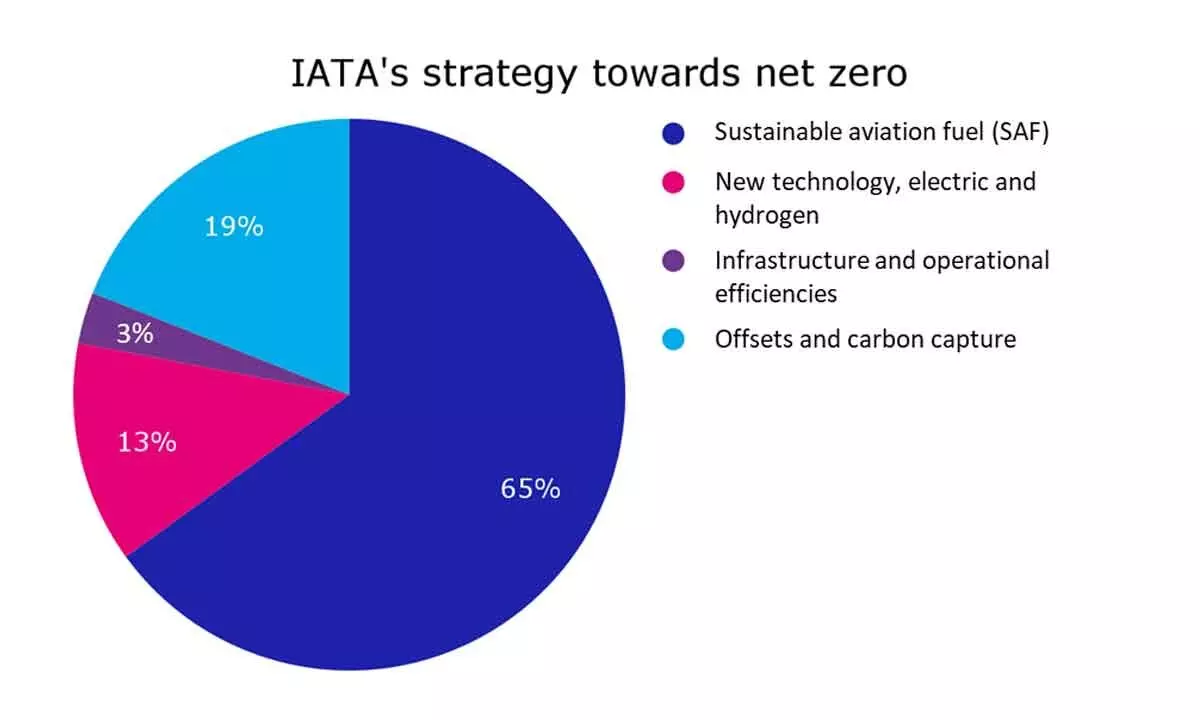SAF technology comes to the global forefront
Transport emissions in India stand at 14 per cent against the 10% global average
image for illustrative purpose

IATA estimates that Sustainable Aviation Fuel (SAF) could contribute around 65% of the reduction in emissions needed by aviation to reach net-zero in 2050. This will require a massive increase in production in order to meet demand
The world’s first transatlantic flight by Virgin Atlantic using 100 per cent sustainable aviation fuel (SAF) flew from London to New York, and thereby demonstrated the capability of SAF as a safe drop-in replacement for fossil derived jet fuel.
The flight took off from Heathrow and landed at JFK airport. Partially funded by the UK government, it is seen as a possible greener way of flying.
SAF can play a crucial role in the decarbonisation of long-haul aviation and pathway to net zero 2050.
The fuel, made from waste products, delivers CO2 lifecycle emissions, resulting in savings of up to 70%, whilst performing like the traditional jet fuel it replaces.
SAF currently makes up less than 0.1% of global jet fuel volumes and fuel standards allow for just a 50% SAF blend in commercial jet engines.
India is aggressively looking at cleaner technology for its transport sector which is one of its major carbon emitters. The transport emissions stand at 14 per cent against a global average of 10 per cent. Within this, the share of passenger and freight vehicles is about 50-50 percent.
Brazil has been spearheading its ethanol blending journey since 1975 prescribing a 20 per cent blend of ethanol with petrol. The composition of ethanol since then has been raised to 27 percent by now. USA, on the other hand, began using renewable fuels and ethanol in 2005. Over a period of time, prescribed ethanol blending with petrol has become a norm in both these countries. Ethanol production is encouraged to take place near agricultural zones directly utilising the crop residue from farms.
IATA estimates that Sustainable Aviation Fuel (SAF) could contribute around 65% of the reduction in emissions needed by aviation to reach net-zero in 2050. This will require a massive increase in production in order to meet demand. The largest acceleration is expected in the 2030s as policy support becomes global, SAF becomes competitive with fossil kerosene, and credible offsets become scarcer. A government policy has an instrumental role to play in the deployment of SAF.
IATA encourages policies which are harmonized across countries and industries, while being technology and feedstock agnostic. Incentives should be used to accelerate SAF deployment.
As SAF is in the early stages of market development, mandates should only be used if they are part of a broader strategy to increase the production of SAF and complemented with incentive programs that facilitate innovation, scale-up and unit cost reduction.
Achieving net zero by 2050 will require a combination of maximum elimination of emissions at the source, offsetting and carbon capture technologies.
Seven biofuel production pathways are certified to produce SAF, which perform at operationally equivalent levels to Jet A1 fuel. By design, these SAFs are drop-in solutions, which can be directly blended into existing fuel infrastructure at airports and are fully compatible with modern aircraft.
In the Middle East, Abu Dhabi Aviation (ADA) and Leonardo announced that an ADA’s AW139 intermediate twin-engine helicopter accomplished two flights powered by aviation fuel blended with SAF (Sustainable Aviation Fuel) in Abu Dhabi on November 28 and 30 with the latter carrying on board UAE dignitaries and industry representatives. These flights using SAF on an ADA’s commercial helicopter marked a first in UAE and the Middle East. This initiative and achievement demonstrate ADA and Leonardo’s capability and active commitment in reducing the impact that aviation has on global carbon emissions.
The civil aviation sector in the UAE is making significant strides toward enhancing the use of sustainable aviation fuel (SAF). More than that, it highlighted that the success of the first helicopter flight using SAF was an important step that supports the ongoing efforts towards reducing carbon emissions in the aviation sector.
During the recently held third ICAO Conference on Aviation and Alternative Fuels at UAE, the world witnessed the launch of the (Dubai Framework) for SAF, which represents the beginning of the path towards a more sustainable future in aviation, aiming to achieve the ambitious goal of reaching zero emissions by 2050.
A global framework has been set up by IATA to promote Sustainable Aviation Fuel (SAF) production across global geographies. The endeavour is that aviation fuel in 2030 is 5% less carbon intensive than fossil fuel used today by the industry.

